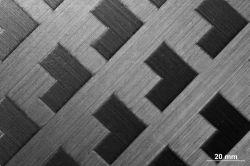
The ‘AP-PLY’ weave pattern combines the advantages of woven fabric (higher resistance to damage) and a unidirectional laminate (improved mechanical properties) in an automated production process.
The National Aerospace Laboratory (NLR) and Delft University of Technology (TU Delft) have jointly developed a new composite material that is more resistant to impacts. This is important for aircraft structures.
Composite materials make aircraft lighter, which can reduce fuel consumption and thus also CO2 emissions. But composites do however have a drawback. When aluminium , the material that most aircraft are constructed of , structures are involved in a collision, the result is a visible indentation. With composites, however, a delamination process can occur inside the material. This means that the layers from which the material is made can break loose, yet this will not be visible from the outside.
Researchers however have recently discovered that by copying a weave pattern, they can now combine the advantages of woven fabric (higher resistance to damage) and a unidirectional laminate (improved mechanical properties) in an automated production process using a fibre placement machine. This result: a laminate with what is known as an ‘AP-PLY’ pattern, which greatly increases the material’s strength after incurring damage. The pattern looks like that of the dough strips on an apple pie, but filled in. Because of the fibres’ superior interconnectedness, damage is restricted to a small area.
The first test results have proved promising and a weight reduction of approximately 10% seems feasible, as compared to the traditional layered structure. Moreover, even greater reductions are expected when the material is further optimized for specific applications. This important discovery stems from PhD research that Martin Nagelsmit is conducting at NLR and TU Delft. The researchers have subsequently applied for a patent.


